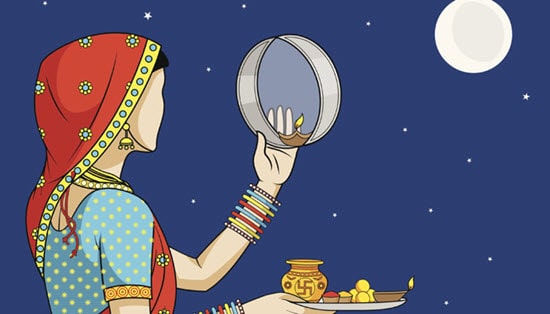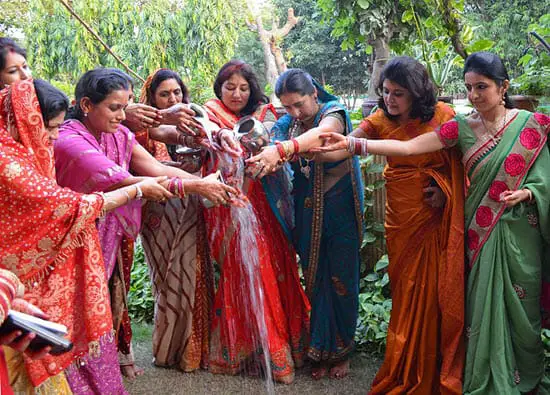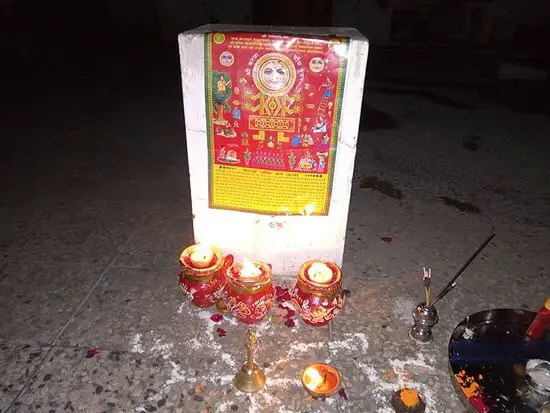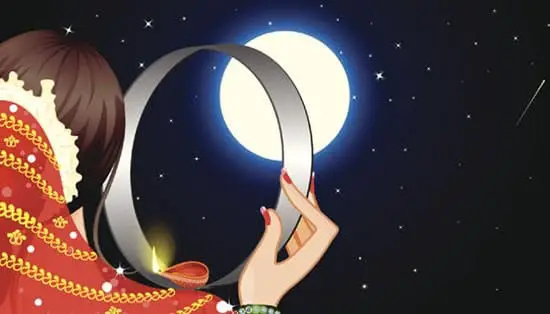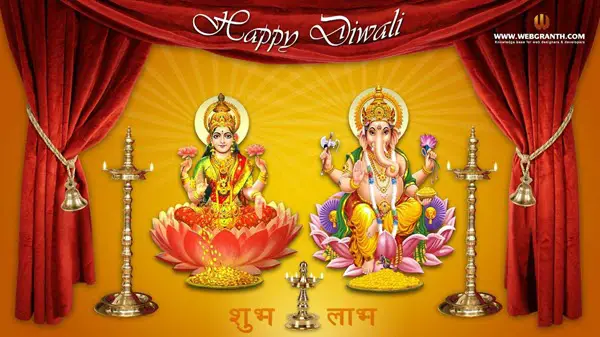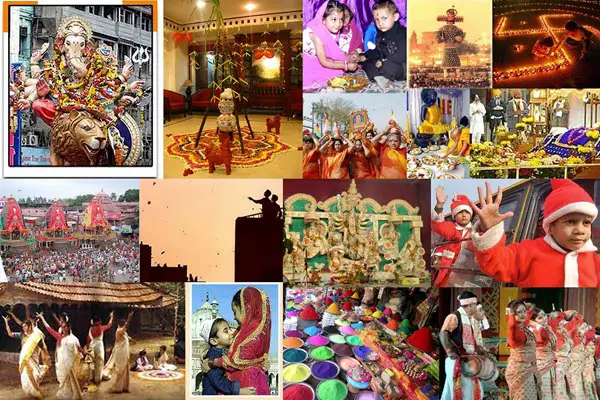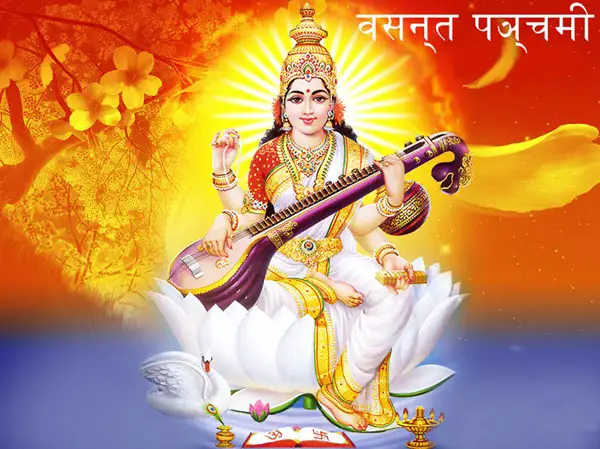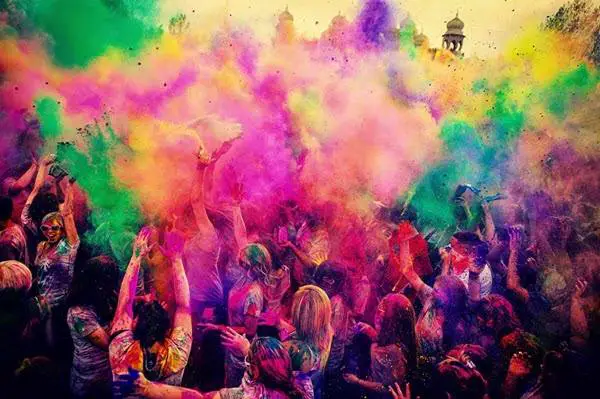Love is the greatest gift of God. It becomes extremely difficult to express the “Magic” of Love. However, the Indian sages, from time immemorial, had known the power and magic of love. And, here comes a festival to experience the same power and magic of love.
Karva Chauth is one such Hindu Festival that honors, remembers, and invites this magical reality called “Love.”
Let us take a few moments to dip into the nectar of “Karva Chauth.”
Table of Contents
Karva Chauth
Marriage in the Hindu Religion is a sacred affair.
Karva Chauth is a Hindu festival celebrating the sacred relation called “Marriage.”
It is a “one-day” festival that married Hindu women celebrate.
Karva Chauth is most prevalent in northern India in states such as Uttar Pradesh, Rajasthan, Punjab, Himachal Pradesh, Delhi, and Haryana.
It is observed in the Hindu month of Kartika on the fourth day after the full moon. This usually falls in October or November.
It is a festival in which married women take to fasting from sunrise to moonrise for their husband’s safety, longevity, and well-being.
However, unmarried women sometimes join the fasting for their fiancés or desired husbands.
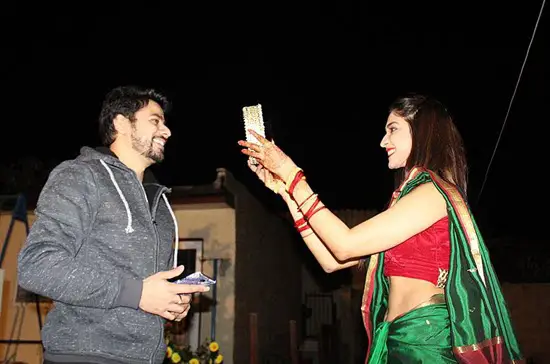
.
The Origin – Why is Karva Chauth celebrated?
“Karva Chauth” has a meaning attached to it.
What’s the meaning?
Let us see.
Karva means “pot” – an earthen pot of water.
Chauth means – fourth (which highlights the fact that the festival is celebrated on the fourth day of Krishna Paksha in the month of Kartika).
The festival of “Karva Chauth” originated in the northwestern part of India.
It has a hypothesis attached to it. Let us explore it.
During the Mughal period, Hindu rulers usually conducted military campaigns to defend against Mughal invaders.
In these actions, they had to leave their wives and children and had to indulge themselves in wars. In this tense atmosphere, their wives took to prayer and observed a day of socializing with other women.
They prepared special meals for their husbands and dressed themselves up in the finest attire before their husbands left for war.
However, women whose husbands had already left for war took to fast to pray to God (Karva Chauth, women prayed to Goddess “Karva Mata”).
There is a pleasant co-incident attached to this festival. The Karva Chauth festival coincides with the wheat sowing time of the Rabi crop cycle.
Karvas (which are big earthen pots) were used to store wheat.
So, the fast is also linked to prayer to God to bless them with a good wheat harvest and other grains.
Karva Chauth is closely associated with the bond of feminine friendship. In India, the custom of arranged marriage is highly prevalent. The newlywed bride has to reside with her husband and the in-laws.
At first, everybody is a stranger to her.
So, a custom arose wherein the newlywed bride befriends another woman as her friend. She was called “Kangan saheli” or “Dharam behn” (sister). She would be her friend for life.
In fact, this friendship between the newlywed bride and her Kangan Saheli was sanctified during the marriage ceremony itself.
The Kangan Saheli usually happens of the same age (or slightly older). She is typically married into the same village (so she may not leave the village and go away) and is not directly related to her in-laws.
Later on, the Karva Chauth festival evolved from this special friendship bond to celebrate and honor the relationship between husband and wife.
On an emotional and psychological front, the festival holds a profound meaning. It honors the special bond of love that exists between husband and wife.
The Hindu religion calls the husband with the salutation of “Pati Devo Bavah,” meaning that the husband is equivalent to an Angel.
A true husband is really like that and should be an Angel for his wife. The festival establishes the love, warmth, care, and respect that this relationship holds with it.
The festival has elaborate customs and practices of celebrating, which differ from one region to another. For example, married women buy new Karvas (spherical clay pots) a few days before Karva Chauth.
It is usually 7″-9″ in diameter and 2-3 liters in capacity. They would paint them from the outside with beautiful designs. The Karvas are stuffed with bangles, ribbons, makeup items, small clothes, sweets, and homemade candy.
Karva Chauth Rituals
The enthusiasm for celebrating Karva Chauth grips married women a few days in advance. They take to buying “Shringar” items (cosmetics), jewelry, and puja items (such as Karva lamps and decorated puja Thali).
Local bazaars adorn a festive look. The shopkeepers put the Karva Chauth products on display.
On the day of Karva Chauth fasting, women awake before sunrise have eatables, and drink water.
For example, in Uttar Pradesh, celebrants have soot feni with milk in sugar on the Karva Chauth festival eve. It helps them to go without water on the day of fasting for Karva Chauth.
In Punjab, Sargi forms the pre-dawn meal and always includes Fenia. Traditionally, Sargi is given to the fasting woman by her mother-in-law.
The Karva Chauth fasting begins at dawn. The celebrants (fasting women) do not eat during the day. The fasting woman does not do any housework on Karva Chauth Day.
They do elaborate make-up, which includes applying henna and other cosmetics. They meet friends and relatives.
In some regions, celebrants give and exchange Karva Chauth Pots filled with bangles, ribbons, homemade candy, small cloth items, and cosmetics.
In the evening, the celebrants take part in a women-only ceremony. They wear fine clothing and jewelry items. In some regions, celebrants wear their wedding dresses.
They usually wear saris, shalwars, or lehengas in red, gold, or orange, which they consider very auspicious colors.
The women fasters sit in a circle with their Puja Thali.

Karva Chauth Vrata Katha is narrated by an older woman or a priest, with regular pauses. In the pauses, the celebrants sing Karva Chauth Puja Song collectively.
They pass their Thalis around in the circle. Songs such as these are sung during the ceremony:
“..Veero kudiye Karvara, Sarva suhagan Karvara, Aye katti naya Teri naa, Kumbh chrakhra feri naa, Aar pair payeen naa, Ruthda maniyen naa, Suthra jagayeen naa, Ve veero kuriye Karvara, Ve sarva suhagan Karvara…”
(It may differ from region to region)
In regions such as Uttar Pradesh and Rajasthan, the celebrants (fasting women) exchange Karvas seven times between themselves.
Participants also offer prayers to Gaur Mata – The Earth.
They take a bit of soil and sprinkle water on it. After this, they apply Kumkum to it. It is regarded as an Idol manifestation of Mother Earth.
In the olden days, the idol of Gaur Mata was made using earth and cow dung. Now, it has been replaced with an idol of Parvati.
Stories are narrated related to Karva Chauth, Shiva, Parvati, and Ganesh.
An earthen lamp is lit in the Thali while listening to the Karva Story. They also keep Sindoor, incense sticks (Dhoop), and rice in the Thali.
They sing,
“…Sadaa suhagan karve lo, Pati ki pyari karve lo, Saat bhaiyon ke behen karve lo, Vart karni karve lo, Saas ki pyaari karve lo…”
After this, they offer a mélange of Goodies such as Halwa, Puri, Namkeen Mathri, and Meethi Mathri to the idols.
The women awaited the moon’s rise once the Fera ceremony concludes.
With the rising of the moon, the fasting woman (with her husband nearby) views the moon’s reflection in a pot or container filled with water through a sieve (छलनी).
Arka (water is offered) is offered to the moon to secure its blessings. She then views the face of her husband indirectly through a sieve.
In some regions, women say a short prayer, seeking the long life of their husbands. They say, “Just like the moon, my Suhaag always shines brightly and has a long life.”
The husband then takes water from the Thali and gives the first sip to her wife. He also offers a sweet to his wife.
This way, the Karva Chauth fast is broken, and the celebrant women can have a full meal.
The Legends of Karva Chauth Festival
There are many legends associated with the Karva Chauth Festival. Here, we share with you the most popular ones.
The Story of Queen Veeravati
Once there was a beautiful queen named Veeravati. She was the only sister of seven loving brothers.
On her first Karva Chauth as a married woman, went to her parent’s house. She began the Karva Chauth fast after sunrise. However, by evening, she was gripped by thirst and hunger.
She desperately waited for the moonrise. Her seven brothers were much grieved to see her in distress.
They created a fall illusion behind a Peepal tree that made her believe the moon had risen.
Veeravati
The Legend of Karva
mistook it for the moon and broke her fast.
The moment she took the first bite of food, the word arrived that her husband (the king) was dead.
She was completely heartbroken. She wept through the night. Her Shakti compelled a Goddess to appear.
The Goddess inquired why she was in such a state of grief and sorrow. Veervati told the Goddess that her brothers had tricked her, and she had mistakenly broken the Karva Chauth fast before the moonrise.
The Goddess instructed her to repeat the Karva Chauth fast with complete devotion.
Veervati completed the fast with complete devotion and forced Yama to restore her husband’s life.
There is another variant of this story. Veervati’s brothers build a massive fire behind a mountain to trick and convince her that it’s the glow of the moon.
Veervati believed her brothers’ trick and broke the fast.
As soon as she took the first bite of food, the word arrived that her husband had died. She began to run towards her husband’s house. On the way, Veervati was intercepted by Shiva-Parvati.
Goddess Parvati told Veervati that her brothers had tricked her into believing that the moon had risen. She broke the fast before the moonrise, and so her husband died.
Parvati cuts her little finger and gives Veervati a few drops of her holy blood. She instructs Veervati to sprinkle the blood on her dead husband’s body. She also told Veervati to adhere to the Karva Chauth fast with complete faith and devotion in the future.
Veervati sprinkled Goddess Parvati’s blood on her dead husband. Her husband rose back to life. They were reunited and lived happily ever after. Veervati kept Karva Chauth fast with complete faith and devotion.
The Legend of Karva
Once upon a time, there was a woman named Karva. She was fully devoted to her husband.
Karva’s immense dedication and love towards her husband gave her profound spiritual power (Shakti).
It so happened that her husband was caught by a crocodile while bathing in a river.
Karva tied the crocodile with cotton yarn and asked Yama to send the crocodile to hell. However, Yama refused.
Karva threatened Yama and said that she would curse him. Yama got afraid, and he did not want to be cursed by a Pati Vrata Nari (woman). He agreed with Karva and sent the crocodile to hell.
Further, Yama blessed her husband with a long life. Karva and her husband lived a happy married life.
Since then, the Karva Chauth festival has been celebrated by married women for their husband’s long life and well-being.
The Legend of Mahabharata
The glory of Karva Chauth Vrata dates back to the pre-Mahabharata times. It is said that Draupadi had observed the Karva Chauth fast. Once, it so happened that Arjun left for the Nilgiris to do penance.
In his absence, the rest of the Pandavas faced many problems.
Draupadi became desperate and prayed to Lord Krishna for help. Lord Krishna told Draupadi that Lord Shiva had advised Parvati to do the fast of Karva Chauth.
Lord Shiva had narrated the story of Veervati to Parvati to bring out the magical power of this fast.
Draupadi observed the Karva Chauth fast with full devotion. The Pandavas overcame all their problems.
The Story of Satyavan and Savitri
When the God of Death, Yama, came to procure Satyavan’s soul, his wife, Savitri, begged him to bring her husband back to life.
However, Yama did not listen to her request. Savitri stopped eating and drinking water and followed Yama, who had carried away her husband’s soul.
Yama was moved by Savitri’s penance and told her that she could ask for any other boon except for her husband’s life.
Savitri asked Yama that she be blessed with children.
As Savitri was a Pati Vrata, Yama was left with no other choice other than to restore her husband’s life.
Satyavan came back to life due to the penance of his wife, Savitri.
Karva Chauth Vrata Katha
Once there lived a rich merchant who had seven sons and a daughter. They were living a happy and fulfilled life.
The merchant married all his sons and daughters.
On the occasion of her first Karva Chauth, the daughter visited her parents’ house. She kept the Karva Chauth fast, along with his mother and sisters-in-law.
In the evening, when the brothers gathered to have their daily meal, they asked their sister to have the meal.
She told them she had kept the Karva Chauth fast for her husband’s well-being and would drink water and take food only after giving “Arka” to the Moon.
Her brothers were much moved by their sister’s answer and wanted to not be under any stress or grief.
They lit a great fire behind a distant mountain and placed a sieve with a lamp on a tree that seemed like a moon.
They told her that the Moon had risen so she could break her fast. Believing her brothers, she gave Arka to the false moon and broke her fast.
Seeing this, Lord Ganesh became angry with her. Her husband got gripped by an intense illness.
She spent all the money to save her husband. She got to know of her fault and repented before Lord Ganesh.
When the Karva Chauth day came, she did the fast with complete devotion and faith.
She broke the fast after seeing the actual Moonrise. Lord Ganesh became pleased to see her do the Karva Chauth fast for her husband’s well-being and life.
Lord Ganesh blessed her and cured her husband. He blessed her husband with a long life and gave immense wealth to them.
Like this, any married woman who keeps Karva Chauth fast with deep faith and devotion is blessed with the Lord’s grace. They live a happy married life.
You may like: Satyanarayan Vrat Katha
Karva Chauth Date 2025
Karva Chauth is a yearly festival that married Hindu women celebrate for their husband’s well-being and long lives.
It is a one-day festival celebrated in the Hindu month of Kartik on the fourth day of Krishna Paksha.
Married women keep a day-long fast, beginning with the sunrise and ending with the moon rising on the same day. They give Arka to the Moon and perform Karva Chauth Puja before breaking their fast.
Karva Chauth will be celebrated on 10th October 2025, Friday
Karwa Chauth Puja Muhurat = 05:57 PM to 07:11 PM
Karva Chauth Moonrise Time 2025 = 08:13 PM
- Chaturthi Tithi Begins = 10:54 PM on 09th October 2025
- Chaturthi Tithi Ends = 07:38 PM on 10th October 2025
Karva Chauth Images
The Karva Chauth is a highly popular festival of the Hindus.
Married women for long life celebrate it and the well-being of their husbands. It establishes and strengthens the loving bond between husband and wife.
Karva Chauth is mainly celebrated in the Northern part of India in Uttar Pradesh, Delhi, Haryana, Punjab, Rajasthan, and Madhya Pradesh, as well as in Gujarat and Mumbai.
Herein, we share a chosen collection of Karva Chauth Images with you that will bring out the festivity and ritual aspect of Karva Chauth in full bloom.
Let’s take a look at the Karva Chauth Images:

